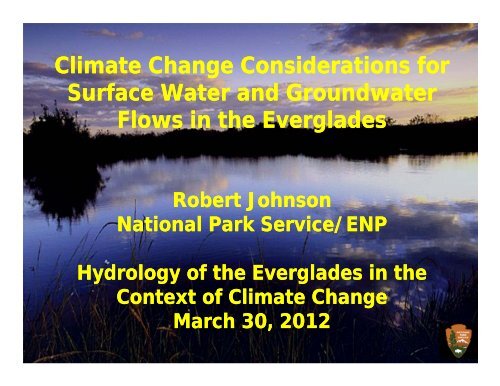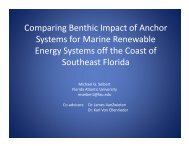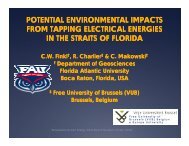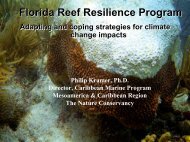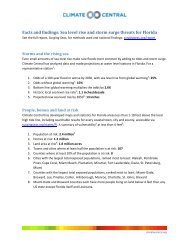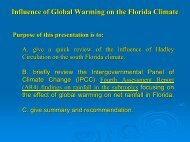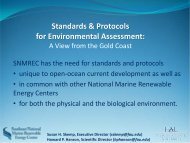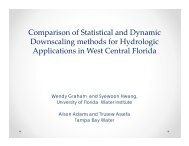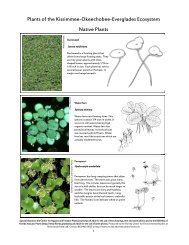Climate Change Considerations for Surface Water and Groundwater ...
Climate Change Considerations for Surface Water and Groundwater ...
Climate Change Considerations for Surface Water and Groundwater ...
- No tags were found...
You also want an ePaper? Increase the reach of your titles
YUMPU automatically turns print PDFs into web optimized ePapers that Google loves.
<strong>Climate</strong> Variability <strong>and</strong> <strong>Water</strong> Management• South Florida rainfall patterns create alternating wet <strong>and</strong> dryperiods, which are difficult to manage.• Stationary assumptions are no longer valid, making it harder toevaluate water resource dem<strong>and</strong>s <strong>and</strong> risks.• <strong>Climate</strong> change predictions suggest increased rainfallvariability, slightly drier wet seasons with increased tropicalcyclone intensity.• Knowledge Gap: Managing extreme rainfall events.
The Current <strong>Water</strong> Management System1,5001505505301,400770170800740950550230Avg. Annual Flows in 1,000 ac-ft/yr470550Current <strong>Water</strong> Budget (LORS/T3)• The Central <strong>and</strong> Southern Florida(C&SF) Project features arerather poor at retaining excesswater following high rainfallperiods.• More than 3.5 million acre-feet ofwater is lost to tide in an averageyear, with 25% coming fromEverglades seepage losses.• The most viable options retainingthis water are adjusting LakeOkeechobee operations,increasing flows into the <strong>Water</strong>Conservation Areas, <strong>and</strong> reducinggroundwater seepage into theLower East Coast.• Each of these options createtradeoffs between flood control,water supply, <strong>and</strong> water quality.
The Impacts of Urban/Agricultural DevelopmentIn the Lower East Coast• Total water use inMiami-Dade,Broward, <strong>and</strong> PalmBeach Countiesincreased from 875to 2,147 MGDbetween 1965 <strong>and</strong>2000.• Average wetseasongroundwater levelsdeclined by 1-3feet (orangecolors) from the1940’s to the1990’s.Source: Impact of Anthropogenic Development in SE Florida, USGS, 2005.
<strong>Water</strong> Management in Lake Okeechobee• Lake Okeechobee inflows routinely exceed outflows, <strong>and</strong> highLake levels impact levee safety <strong>and</strong> damage the littoral zone.• Lowering Lake levels creates harmful discharges to the northernestuaries, <strong>and</strong> significantly impacts regional water availability.• Knowledge Gaps: Greater outflow flexibility, development ofoptimal long-term operations <strong>for</strong> sustainability.Hurricanes Charley,Frances, Jeanne, Aug –Sept 2004Hurricane Wilma,Oct 2005RegulationSchedule<strong>Change</strong>Tropical Storm Fay,Aug 2008
Reducing Seepage Losses from the Everglades• <strong>Water</strong> Preserve Areas: Capture<strong>and</strong> store excess runoff from theLower East Coast currently goingto tide.• ENP Seepage Mgmt.: Install abarrier to block groundwaterseepage.• Knowledge Gap: Determine themost cost effective method.EvergladesAgriculturalAreaWCA-3ALox.NWRWCA-2AStrazzullaWetl<strong>and</strong>sSeepageBarrierHard Layer (Q4)Hard Layer (Q3)ENP Seepage Mgmt.Modified WD,C-111 SD,C-111 SC
The Post-CERP <strong>Water</strong> Management System1,410754907201901,70028020550506201080500 850240240Avg. Annual Flows in 1,000 ac-ft/yrFuture <strong>Water</strong> Budget (CERPA)• Proposed CERP features wouldretain on average 950,000 acrefeet/yearcurrently lost to tide.• This would increase resilience ofthe water management system toclimate variability, climatechange, <strong>and</strong> sea level rise.• The concern is that many of theoriginal CERP water storagefeatures (regional ASR, Lakebelt,<strong>Water</strong> Preserve Areas) are nolonger considered viable.• Knowledge Gaps: New storageapproaches (Lake O./EAA/WCAs),<strong>and</strong> new optimization tools thatmaximize restoration benefitswhile enhancing long-term watersustainability <strong>for</strong> the builtsystem.


